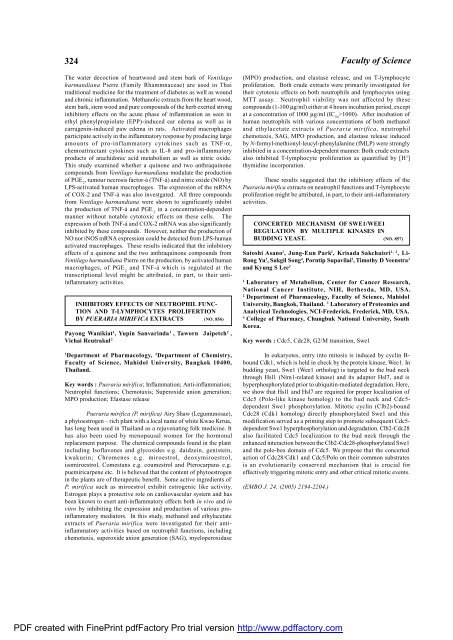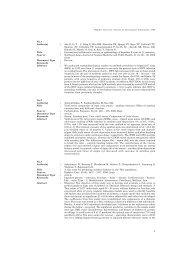Faculty of Science - Mahidol University
Faculty of Science - Mahidol University
Faculty of Science - Mahidol University
Create successful ePaper yourself
Turn your PDF publications into a flip-book with our unique Google optimized e-Paper software.
324<br />
The water decoction <strong>of</strong> heartwood and stem bark <strong>of</strong> Ventilago<br />
harmandiana Pierre (Family Rhammnaceae) are used in Thai<br />
traditional medicine for the treatment <strong>of</strong> diabetes as well as wound<br />
and chronic inflammation. Methanolic extracts from the heart wood,<br />
stem bark, stem wood and pure compounds <strong>of</strong> the herb exerted strong<br />
inhibitory effects on the acute phase <strong>of</strong> inflammation as seen in<br />
ethyl phenylpropiolate (EPP)-induced ear edema as well as in<br />
carragenin-induced paw edema in rats. Activated macrophages<br />
participate actively in the inflammatory response by producing large<br />
amounts <strong>of</strong> pro-inflammatory cytokines such as TNF-α,<br />
chemoattractant cytokines such as IL-8 and pro-inflammatory<br />
products <strong>of</strong> arachidonic acid metabolism as well as nitric oxide.<br />
This study examined whether a quinone and two anthraquinone<br />
compounds from Ventilago harmandiana modulate the production<br />
<strong>of</strong> PGE 2 , tumour necrosis factor-á (TNF-á) and nitric oxide (NO) by<br />
LPS-activated human macrophages. The expression <strong>of</strong> the mRNA<br />
<strong>of</strong> COX-2 and TNF-á was also investgated. All three compounds<br />
from Ventilago harmandiana were shown to significantly inhibit<br />
the production <strong>of</strong> TNF-á and PGE 2 in a concentration-dependent<br />
manner without notable cytotoxic effects on these cells. The<br />
expression <strong>of</strong> both TNF-á and COX-2 mRNA was also significantly<br />
inhibited by these compounds. However, neither the production <strong>of</strong><br />
NO nor iNOS mRNA expression could be detected from LPS-human<br />
activated macrophages. These results indicated that the inhibitory<br />
effects <strong>of</strong> a quinone and the two anthraquinone compounds from<br />
Ventilago harmandiana Pierre on the production, by activated human<br />
macrophages, <strong>of</strong> PGE 2 and TNF-á which is regulated at the<br />
transcriptional level might be attributed, in part, to their antiinflammatory<br />
activities.<br />
INHIBITORY EFFECTS OF NEUTROPHIL FUNC-<br />
TION AND T-LYMPHOCYTES PROLIFERTION<br />
BY PUERARIA MIRIFICA EXTRACTS (NO. 856)<br />
Payong Wanikiat 1 , Yupin Sanvarinda 1 , Taworn Jaipetch 2 ,<br />
Vichai Reutrakul 2<br />
1 Department <strong>of</strong> Pharmacology, 2 Department <strong>of</strong> Chemistry,<br />
<strong>Faculty</strong> <strong>of</strong> <strong>Science</strong>, <strong>Mahidol</strong> <strong>University</strong>, Bangkok 10400,<br />
Thailand.<br />
Key words : Pueraria mirifica; Inflammation; Anti-inflammation;<br />
Neutrophil functions; Chemotaxis; Superoxide anion generation;<br />
MPO production; Elastase release<br />
Pueraria mirifica (P. mirifica) Airy Shaw (Legumunosae),<br />
a phytoestrogen – rich plant with a local name <strong>of</strong> white Kwao Krrua,<br />
has long been used in Thailand as a rejuvenating folk medicine. It<br />
has also been used by menopausal women for the hormonal<br />
replacement purpose. The chemical compounds found in the plant<br />
including Is<strong>of</strong>lavones and glycosides e.g. daidzein, genistein,<br />
kwakurin; Chromenes e.g. miroestrol, deoxymiroestrol,<br />
isomiroestrol, Comestans e.g. coumestrol and Pterocarpans e.g.<br />
puemiricarpene etc. It is believed that the content <strong>of</strong> phytoestrogen<br />
in the plants are <strong>of</strong> therapeutic benefit. Some active ingredients <strong>of</strong><br />
P. mirifica such as miroestrol exhibit estrogenic like activity.<br />
Estrogen plays a protective role on cardiovascular system and has<br />
been known to exert anti-inflammatory effects both in vivo and in<br />
vitro by inhibiting the expression and production <strong>of</strong> various proinflammatory<br />
mediators. In this study, methanol and ethylacetate<br />
extracts <strong>of</strong> Pueraria mirifica were investigated for their antiinflammatory<br />
activities based on neutrophil functions, including<br />
chemotaxis, superoxide anion generation (SAG), myeloperoxidase<br />
(MPO) production, and elastase release, and on T-lymphocyte<br />
proliferation. Both crude extracts were primarily investigated for<br />
their cytotoxic effects on both neutrophils and lymphocytes using<br />
MTT assay. Neutrophil viability was not affected by these<br />
compounds (1-100 μg/ml) either at 4 hours incubation period, except<br />
at a concentration <strong>of</strong> 1000 μg/ml (IC 50 >1000). After incubation <strong>of</strong><br />
human neutrophils with various concentrations <strong>of</strong> both methanol<br />
and ethylacetate extracts <strong>of</strong> Pueraria mirifica, neutrophil<br />
chemotaxis, SAG, MPO production, and elastase release induced<br />
by N-formyl-methionyl-leucyl-phenylalanine (fMLP) were strongly<br />
inhibited in a concentration-dependent manner. Both crude extracts<br />
also inhibited T-lymphocyte proliferation as quantified by [H 3 ]<br />
thymidine incorporation.<br />
These results suggested that the inhibitory effects <strong>of</strong> the<br />
Pueraria mirifica extracts on neutrophil functions and T-lymphocyte<br />
proliferation might be attributed, in part, to their anti-inflammatory<br />
activities.<br />
CONCERTED MECHANISM OF SWE1/WEE1<br />
REGULATION BY MULTIPLE KINASES IN<br />
BUDDING YEAST. (NO. 857)<br />
Satoshi Asano 1 , Jung-Eun Park 1 , Krisada Sakchaisri 1, 2 , Li-<br />
Rong Yu 3 , Sukgil Song 4 , Porntip Supavilai 2 , Timothy D Veenstra 3<br />
and Kyung S Lee 1<br />
1 Laboratory <strong>of</strong> Metabolism, Center for Cancer Research,<br />
National Cancer Institute, NIH, Bethesda, MD, USA.<br />
2 Department <strong>of</strong> Pharmacology, <strong>Faculty</strong> <strong>of</strong> <strong>Science</strong>, <strong>Mahidol</strong><br />
<strong>University</strong>, Bangkok, Thailand. 3 Laboratory <strong>of</strong> Proteomics and<br />
Analytical Technologies, NCI-Frederick, Frederick, MD, USA.<br />
4 College <strong>of</strong> Pharmacy, Chungbuk National <strong>University</strong>, South<br />
Korea.<br />
Key words : Cdc5, Cdc28, G2/M transition, Swe1<br />
In eukaryotes, entry into mitosis is induced by cyclin Bbound<br />
Cdk1, which is held in check by the protein kinase, Wee1. In<br />
budding yeast, Swe1 (Wee1 ortholog) is targeted to the bud neck<br />
through Hsl1 (Nim1-related kinase) and its adaptor Hsl7, and is<br />
hyperphosphorylated prior to ubiquitin-mediated degradation. Here,<br />
we show that Hsl1 and Hsl7 are required for proper localization <strong>of</strong><br />
Cdc5 (Polo-like kinase homolog) to the bud neck and Cdc5dependent<br />
Swe1 phosphorylation. Mitotic cyclin (Clb2)-bound<br />
Cdc28 (Cdk1 homolog) directly phosphorylated Swe1 and this<br />
modification served as a priming step to promote subsequent Cdc5dependent<br />
Swe1 hyperphosphorylation and degradation. Clb2-Cdc28<br />
also facilitated Cdc5 localization to the bud neck through the<br />
enhanced interaction between the Clb2-Cdc28-phosphorylated Swe1<br />
and the polo-box domain <strong>of</strong> Cdc5. We propose that the concerted<br />
action <strong>of</strong> Cdc28/Cdk1 and Cdc5/Polo on their common substrates<br />
is an evolutionarily conserved mechanism that is crucial for<br />
effectively triggering mitotic entry and other critical mitotic events.<br />
(EMBO J. 24, (2005) 2194-2204.)<br />
PDF created with FinePrint pdfFactory Pro trial version http://www.pdffactory.com<br />
<strong>Faculty</strong> <strong>of</strong> <strong>Science</strong>
















